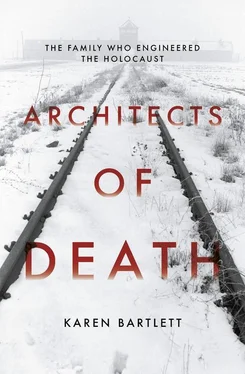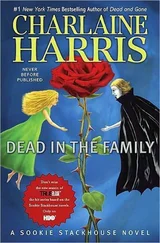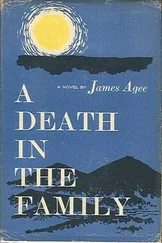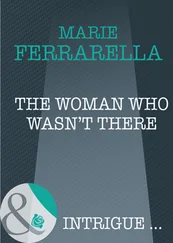For the remaining members of the Topf family, this was a setback. Yet, it was far from the end of the story. For Ernst Wolfgang Topf, the loss of the company was merely a waypoint in the ongoing efforts to clear his name and re-found Topf and Sons in the West. He would dedicate the rest of his life to achieving this goal.
Together with his sister Hanna, Ernst Wolfgang had set up a new company in Gudensberg, a small town near Kassel, as early as 2 November 1945 – while he was still actively fighting to retain control of Topf and Sons in Erfurt. The new company, J. Topf GmbH, was listed as a hardware retailer and Johanna Topf, Ernst-Otto Keyser and Heinrich Mersch were all shareholders. (Mersch, the managing director of the new company, was a former head of planning at Topf and Sons and was in a relationship with Johanna Topf.)
From the beginning, however, the Topfs’ new enterprise was dogged by revelations of their business dealings during the war. On 6 March 1946, local Kassel newspaper Hessische Nachrichten published an article titled ‘Soap from human fat’, detailing how the Nazis exploited the murder of millions for profit, including breaking teeth and melting down gold fillings, stuffing mattresses with women’s hair and stealing all of the belongings of those sent to concentration camps (although they did not make soap from human fat). The article, which was based on prosecution documents presented at the first Nuremberg trial, goes on to name companies which supplied cremation ovens: the Kori company, Didier-Werke and Topf and Sons. ‘In the offices of the Auschwitz concentration camp, members of the Soviet State Commission found extensive correspondence between the camp management and the company of Topf & Sons, Erfurt.’ [133] Schüle, op. cit., p. 304. Article in Kassel newspaper Hessische Nachrichten. AS footnote 95: The Major War Crimes Trial took place from 18 October 1945 to 1 October 1946 before the International Military Court of the four victorious powers: USSR, USA, Great Britain and France. See for example Helge Grabitz, ‘Die Verfolgung von National Socialist-Verbrechen in der Bundesrepublik Deutscland und in der DDR’ [‘The pursuit of National Socialist crimes in the Federal Republic of Germany and the GDR’] in: Claudia Kuretsidis-Haider and Winfried R. (eds), Garscha, Keine ‘Abrechnung’. NS-Verbrechen, Justiz und Gesellschaft in Europa nach 1945 [ No ‘Settlement’. National Socialist Crimes, Justice and Society in Europe after 1945 ], Leipzig/Vienna, 1998, pp. 144–79, here pages 147ff; Annette Weinke, Die Nürnberger Prozesse [ The Nuremberg Trials ], Munich, 2006. AS footnote 96: Hessische Nachrichten, Kassel, 6 March 1946, p. 6, emphases in the original. AS footnote 97: See Philipp Kratz, Strategien der Verdrängung: Der Umgang mit dem Holocaust in Wiesbaden der 1950er Jahre [Blocking-out Strategies: How the Holocaust was Dealt With in 1950s Wiesbaden], unpublished dissertation, Wiesbaden 2007, p. 55, note 211. Kratz bases his argument on Hellmuth Merbach, ‘Seife aus Judenfett’ [Soap from Jewish Fat] in: Wolfgang Benz (pub), Legenden Lügen Vorurteile, Ein Lexicon der Zeitgeschichte [ Legends, Lies, Prejudices, A Lexicon of Contemporary History ], Munich 1990, p. 172f.
Even at a time of such political upheaval and revelations, it appears that one reader of the Hessische Nachrichten was paying attention, lodging a criminal complaint against Ernst Wolfgang and leading the US Counter Intelligence Corps (CIC) to reopen its investigation.
This ‘dirty denunciation from a Gudensberg resident,’ as Kurt Schmidt described it, [134] Schüle, op. cit., p. 304. AS footnote 98: Kurt Schmidt also wrote to the Fritzlar district commission and the district commissioner of Fritzlar-Homberg, Gudensberg, on 29 September 1946, saying that the content of the article did not correspond to reality. ThHStAW, Collection Jean-Claude Pressac Nr 80, sheet 322. In a file note Kurt Schmidt also used the abbreviation ‘V-Ö’ when referring to the cremation furnaces [Verbrennungsöfen]. File note on matters relating to J. Topf G.m.b.H., Gudensberg, 19 August 1946, ThHStAW, Collection Jean-Claude Pressac Nr 80, sheet 312.
had far-reaching consequences. On 25 March 1946, Ernst Wolfgang was questioned by the CIC and issued a statement where he claimed upon his ‘sacred oath’ that Topf and Sons was never involved in the ‘horrors, such as the recovery of gold teeth and hair,’ and that the company’s ‘perfectly normal’ transactions with the SS were extremely urgent war orders that he would have been ‘severely punished’ for delaying or sabotaging. Clearly Topf and Sons had never thought it had anything to hide, he added, otherwise the company would never have stamped its logo on the cast-iron fittings for the camp crematoria. ‘Had we known or suspected that they were to be used for anything evil, my brother would have omitted the company logo from the parts lists.’ [135] Ibid., pp. 304–305. AS footnote 100: Sworn statement of Ernst Wolfgang Topf, 26 March 1946, ThHStAW, Collection Jean-Claude Pressac Nr 81, sheets 71–76, here sheet 72.
More truthfully, perhaps, he would have stated that neither brother thought he would have to face the consequences of his actions.
After holding Ernst Wolfgang Topf under arrest for two or three weeks, the American CIC released him without charge, after failing to locate the crucial evidence needed to prosecute him. Soon after, however, Topf was to become embroiled in the much longer process of a denazification tribunal, which would last from April 1946 until March 1950.
Not long after the denazification investigation against Ernst Wolfgang began, J. Topf GmbH collapsed. Topf himself had left Gudensberg (probably as a result of the notorious newspaper article) to live with his parents-in-law in Wiesbaden. The company that Kurt Schmidt reported was in a ‘desolate state’ had been taken over by Heinrich Mersch, who had fallen out with the Topfs and renamed the company after himself.
The denazification process applied to everyone living in the American-occupied zone – and began with a requirement that every citizen fill out a notification form about their relationship to the Nazi Party. Ernst Wolfgang Topf did this on 26 April 1946, stating that he rejected national socialism – and that he had actively opposed it for the entire twelve years of Nazi rule. In a statement he claimed that he had joined the party at ‘the last moment’ in 1933 and had done so to prevent the ‘anti-Semitic demon’ that had already broken out at Topf and Sons.
As a member of the party, however, his case was put forward for investigation at a denazification tribunal – which were lay courts largely implemented by Germans themselves under guidelines laid down by the American military. Those incriminated were called before a hearing and assigned to one of five categories: major offenders, offenders, lesser offenders, followers and exonerated persons.
Ernst Wolfgang’s case came before the Fritzlar-Homberg denazification tribunal in Hesse. Topf began preparing his defence by asking the works council at Topf and Sons in Erfurt to issue him with another Certificate of Political Innocuousness, as they had done in 1945 – but there is no record that they did this. By August that year, however, the charges levelled against Ernst Wolfgang Topf were beginning to seem more serious, with three people writing to Topf to tell him that he was accused of producing the inward and outward ventilation systems for the gas chambers.
Ernst Wolfgang replied in his usual, slightly hysterical and disingenuous manner, claiming that he was a ‘deceived victim’. Topf replied that even the fitters themselves could not have ‘divined that an inward and outward ventilation system could be abused!’ and added that the system in itself was ‘the most innocent thing in the world’. [136] Ibid., p. 308. AS footnote 112: Underlining in the original. Ernst Ludwig Topf to Dr. Grünefeld 3 September 1946 (transcript), ThHStAW, Collection Jean-Claude Pressac Nr 80, sheets 339–41.
Читать дальше












